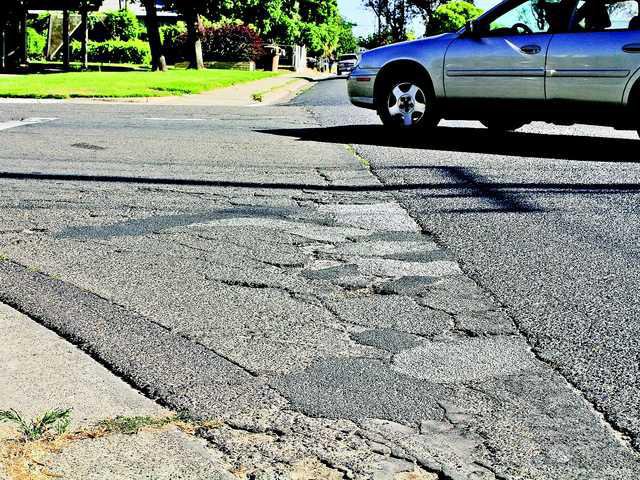Debby Moorhead walked in the shoes of Tappan Place residents. And she didn’t like what she saw.
The Manteca councilwoman said she came across a crack in the street asphalt so wide that it was approaching a half a foot in width and was filled with grass.
“It’s just about the worst I’ve ever seen,” Moorhead said of the street east of the Tidewater Bikeway and off Alameda Street during Tuesday’s City Council meeting.
Moorhead said she fears that someone is going to trip and get hurt crossing the street.
But as Manteca neighborhood streets go, it may not be the worst.
Streets in the Springtime Estates neighborhood built in the late 1980s in the triangle formed by Louise Avenue, Main Street and Highway 99 have deteriorated so much that they will have to be completely replaced at a cost of $2.3 million.
That, believe it or not, was the good news.
Manteca needs to spend a minimum of $5.5 million a year to prevent much of its 200 plus miles of streets from getting to the point they will need expensive replacement work such as at Springtime Estates. The city is only able to fund street maintenance work to the time of $1.5 million annually.
And as the need for street maintenance increases in Manteca and the rest of California, the main source of revenue to do such work — per gallon tax on gas — has not been increased in 20 years. Also cutting into revenue is more fuel efficient vehicles using less gas and therefore generating less taxes even as miles driven increases. Then there are zero emission vehicles such as Teslas and Chevy Volts that do not run on gas allowing drivers to avoid paying gas taxes that pay for roadwork.
The City Council on Tuesday voted to seek bids for the Springtime Estates work as well as a slurry seal of 33 lanes miles in the area generally bounded by Airport Way on the west, Union Road on the east, Louise Avenue on the north, and Crom Street on the south as swell as the Sherwood Forest Subdivision, Units No. 1 and No. 2, north and northeast of East Union High and Neil Hafley School.
But receiving bids doesn’t mean both projects will get done this year.
The Springtime Estates work that was left out of last year’s slurry seal project because the pavement was so bad and needed replacement is expected to come in at $2.3 million. The slurry seal project is projected to cost $1.9 million.
The city has $750,000 in Measure K tax receipts for road maintenance and $650,000 from the state’s Local Transportation Fund to do the work plus $585,000 that wasn’t spent last year. That comes to $1.985 million.
Public Works Director Mark Houghton said when the bids come back staff will hopefully be able to present the council with some funding options. That includes taking money from future years of street maintenance work involving Measure K and Local Transportation Fund taxes so both projects could be completed.
Houghton said staff — in checking the streets in Springtime Estates — discovered no base had been out in place 30 years ago. That makes trying to slurry seal the streets a futile gesture that would simply waste money.
Two options were outlined in the bid. One calls for the existing street pavement to be ground up in place and used as the base or rip everything out, haul it out, and bring in new base material prior to paving the streets.
Councilman Mike Morowit said the understood the city’s funding dilemma in not being able to do all work in a timely fashion. He did, however, want to see the city establish a program where temporary repairs involving patching sections of streets by staff could be done to lower the risks to the public from potholes and cracking.
“I know we don’t have the money to do 100 percent jobs on the streets,” Morowit said, adding that he wanted to see a plan to tackle the most egregious pavement issues on a piecemeal basis.
Houghton noted Manteca uses its share of federal road funds to tackle work on major streets.
That is how the work repaving Main Street from Yosemite Avenue to Woodward Avenue will be done later this year as well as Yosemite Avenue from Main Street to Cottage Avenue in 2018.
To contact Dennis Wyatt, email dwyatt@mantecabulletin.com
MANTECA STREETS CRACKING UP
Springtime Estates streets so bad they need repaving





